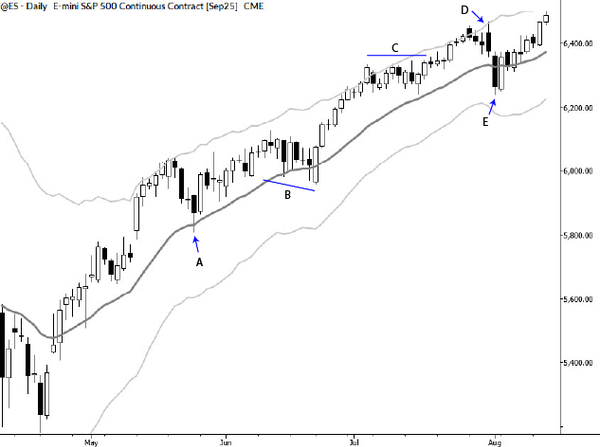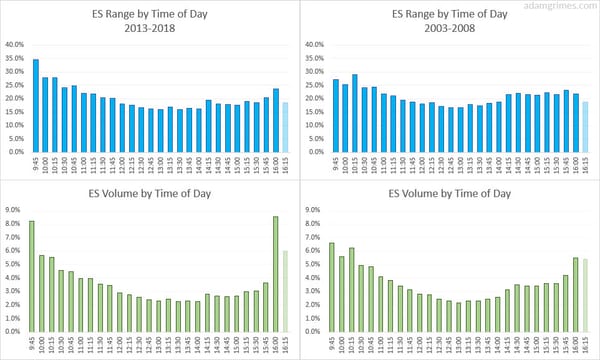Guest Post: The Sunday Night Dream
This is a guest post from my friend (and a trader and author for whom I have tremendous respect) Kevin Davey. I first "found him" through his book. I read many trading books each year, most of which I end up skimming after the first few pages, and quite a few of which I stop reading in disgust. Kevin's book was different. I read the whole thing, and kept thinking "this guy is different... this book is different..." And he is. Check out his bio and links after the story...

Its 11 PM Sunday night, and you are psyched. You are ready to go tomorrow morning. You’ve studied for a couple of months for this. You’ve read a bunch of books, watched You Tube “experts” do exactly what you’ll be doing, and you’ve even done some simulated practice at home on your own.
You know it is hard, but the video experts tell you that you can do it – you just have to overcome your mental blocks. You can accomplish anything now that you have “book smarts,” the half dozen or so books you’ve read tell you. Heck, you have heard of many people succeeding – why not you? In the back of your mind, you know the reality is many people want to do exactly what you are doing, but just can’t hack it. But in your heart, you feel you are different, somehow better.
As you lie in bed Sunday night, your thoughts start to drift, right before you fall asleep. You imagine yourself at home on Monday night, after it is all over. You are sitting back in a recliner, maybe with a drink or a cigar, with a slight smile, some would say a smug expression, on your face. You’ve done what everyone said was impossible. You feel like the King Of The World!
Monday morning comes and you are nervous, but ready. You know if you fail, it will cost you emotionally, mentally and especially financially. But you enter the room, confident and self-assured as can be, and go to your workstation. You announce to no one in particular “let’s get this started!”
The orderlies roll in the heart transplant patient. He has been prepped and is ready for you to start operating…
Wait, what??
Sounds crazy, doesn’t it? Actually, it is a pretty far-fetched scenario – someone attempting a mentally and financially (think malpractice) dangerous activity with no experience. This would never happen in the real world, right?
Well, maybe it could…
Now go back, and instead of thinking this is a new surgeon’s first day on the job, imagine it is a trader starting his or her first day of real money trading. Doesn’t sound so crazy now, does it? Maybe this even describes your start in trading – parts of it definitely ring true for me.
Both activities can be financially rewarding, for sure. And both activities are mentally and emotionally stressful. Yet one activity requires years of formalized education, years on the job experience and years of testing – a ton of work before you are allowed to be a lead surgeon. The other merely requires a pulse, a credit card, and the ability to fill out a simple application - then you can start trading!
What is wrong with this picture?
The concept is called “barriers to entry.” It is a business school / economics term that recognizes that some activities take a lot of capital and preparation to get off the ground. You can’t be a surgeon after watching some videos, you can’t open a jet airliner plant in your garage, and you can’t argue cases in front of the Supreme Court without passing the bar exam. The barriers to entry are just too high.
But you can open a trading account with no training or experience – the barriers to entry are super low. Does not mean you should, of course. And that is where the fallacy of successful trading starts. Since people can easily open an account with a few hundred dollars, they think it is an easy endeavor.
I get e-mails practically every day – people wanting to start trading with $1000, $500 or even as little as $250. People thinking they can make a nice part-time income trading for 15 minutes before they go to their “real” job. Or retirees looking to make a few easy bucks to supplement Social Security, to stave off employment at McDonald's.
Since many brokers allow you to open an account with such small amounts, success must be possible, right?
Well, here is the reality. Trading is hard. Very hard. I always tell people “trading is the hardest way to make easy money.” I used to be in charge of Quality and Engineering for a company that made flight critical airplane parts – if our part failed, many people would likely die. Imagine the pressure and the stress of that. Yet, trading is more difficult – much more difficult.
Of course, trading is immensely appealing, especially to the younger generation, who’ve grown up in a world of a seemingly never-ending bull market. And trading also appeals to other ages too, like it always has for hundreds of years.
So, knowing all this, what is a good way forward for someone wanting to trade? Here are five steps you can take.
First, block out all the nonsense you hear about how easy trading is. Twitter seems to be a haven for young, successful, never lose traders. Except probably 99% of them are lying – most just paper trade from their parent’s basement, if they even do that. The old adage “if it sounds too good to be true” definitely holds here. My rule of thumb is that if I see signs of “trader porn” – fancy cars, bikini clad women, stacks of cash – I immediately ignore it. Real traders rarely, if ever, act that way.
Second, get educated. If you do not know which educator to trust, just read whatever you can, from whomever you can. But read with a critical mind. You’ll soon be able to distinguish fact from fiction, and you’ll learn how to ignore the b.s. so prevalent in this field.
Third, get yourself an edge – a method, strategy or approach that you have proven to yourself is successful. Think of yourself as a casino – you want the house edge working for you, not against you.
Fourth, realize that risk management is one key to your success. Risking it all because you believe you have an edge is no way to trade. Expect edges to fade away, and expect trading to always be tough, even after you have years of experience. While you are playing offense, trying to score profits, remember that defense – protecting your capital – is important, too.
Fifth, and finally, be ready to repeat steps 1 through 4 over and over again. You have to always be improving, reminding yourself to ignore the hype, constantly educating yourself, finding new edges and managing your risk. Let your guard down even for a minute, and you’ll find yourself amongst the market’s losers.
The bottom line is that trading is very, very hard. In many ways, being a successful trader is no different than being successful in any other endeavor. But with work and determination, you can be successful. Just don’t let trading’s low barrier to entry fool you.
About the Author Kevin Davey
Kevin J. Davey is a full-time professional trader and a top performing systems developer. Kevin is the author of the best-selling trading book “Building Algorithmic Trading Systems: A Trader’s Journey From Data Mining to Monte Carlo Simulation to Live Trading” (Wiley Trading, 2014.). He generated triple digit annual returns of 148 percent, 107 percent, and 112 percent in three consecutive World Cup of Futures Trading Championships® using algorithmic trading systems.
His web site, www.kjtradingsystems.com, provides trading mentoring, trading workshops, and free trading videos and articles. Kevin is the creator of The Strategy Factory®, a unique trademarked process to develop algorithmic trading strategies.
Active in social media, Kevin has over 14,000 Twitter followers. An aerospace engineer and MBA by background, he has been an independent trader for over 25 years. Kevin continues to trade full-time and develop algorithmic trading strategies.



